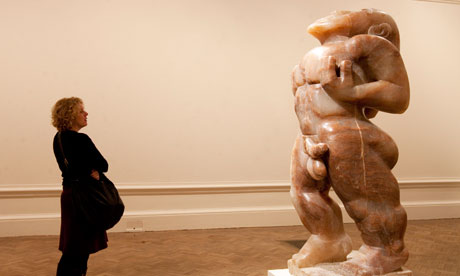Modern British Sculpture: empire of the oddballs
Inspired by artefacts plundered from around the world, Britain's sculptors, from Moore to Hepworth to Hirst, let their visions run riot. Adrian Searle applauds a heavyweight new show

Photograph: David Levene for the Guardian
Modern British Sculpture opens with a model and some photographs. The model is a three-quarter-size replica of Edwin Lutyens's 1919 Whitehall Cenotaph. The photographs blown up on the surrounding walls depict the controversial but largely decorous naked and semi-naked figures with which, in 1908, Jacob Epstein once decorated the exterior of the British Medical Association building on the Strand, and which were removed before the second world war.
- Modern British Sculpture
- Royal Academy of Arts,
- London
- Starts 22 January
- Until 10 April
- Details:
0844 209 0051 - The mocked-up Cenotaph is pale, serious, and somehow irrefutable. I have long thought it a great sculpture, with its slightly inclined vertical planes, which, if projected, would meet a thousand feet above the earth's surface. Photographed in grainy black and white, Epstein's high-relief sculptures are naked, grubby with London soot, ruined temporary plaster figures.
Temporary like us. This space has the feel of a mausoleum, a place of death and commemoration. Then, through a doorway, we are tantalised by things displayed in spotlit gloom: a black basalt Easter Island figure, an ancient Egyptian baboon, a phallic woman carved by the overheated Eric Gill. Is this going to be a fun show, or what?
British British Sculpture Sculpture is the title of the essay by curator (and recently appointed director of Tate Britain) Penelope Curtis that opens the catalogue. The same title adorns the essay by her co-curator, British sculptor Keith Wilson at the end of the book. Is it me, or is there an echo in here? One cannot but wonder to what degree this exhibition indicates Curtis's future direction of Tate Britain. It tries to tell one among many stories of modern art, in a limited space, and is no worse for bringing less well known artists and works to the foreground, while ignoring others. And who needs another coffee-table pop-up sculpture show and catalogue of the usual big names?
The show is full of echoes: of ancient African, Egyptian and oceanic art, Greek sculpture, the fragile clatter of Chinese porcelains and Bernard Leach pots, the pomp of Victorian Britain and of the imperialist mindset that filled the British Museum with artefacts from other cultures and other times, influencing generations of sculptors.
Britain bought, looted and collected from the world, wherever navy and empire went. Artists in their turn – Moore to Gill, Barbara Hepworth, the almost forgotten Maurice Lambert and Leon Underwood – stole from the treasure horde in the British Museum, as well as from their European peers. Their demonstrable craft and frequent self-regarding preciosity is wearying. They wished to be original, but mostly turned into mannerists.
go to http://www.guardian.co.uk/ to read the full article.....


No comments:
Post a Comment